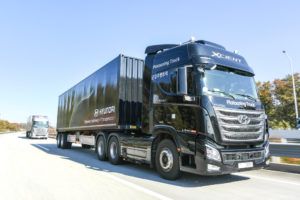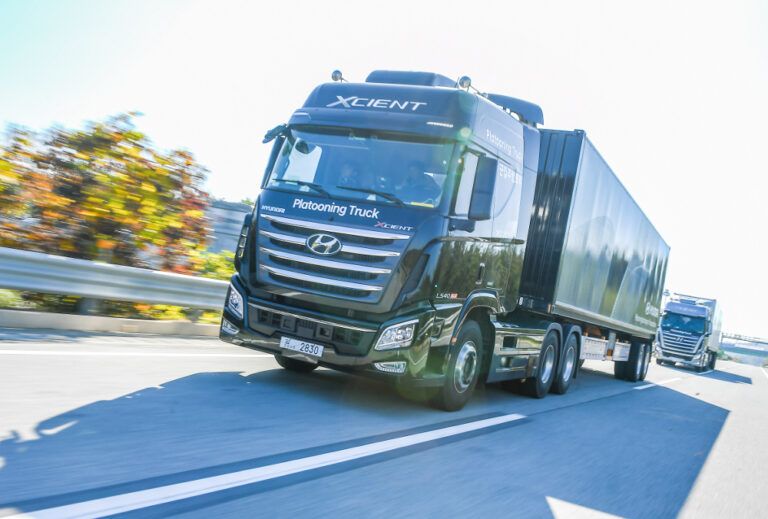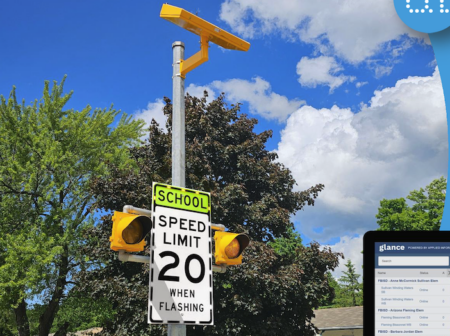South Korean automaker Hyundai has successfully conducted the company’s first autonomous truck platooning demonstration on the country’s Yeoju Smart Highway replicating real-world traffic conditions.
The demonstration is part of a project initiated by the Korean Ministry of Land, Infrastructure and Transport (MOLIT), which has been working to support pioneering efforts for autonomous technology since 2018. Hyundai conducted the trial using two connected 40-ton Xcient tractor-trailer trucks on the 4.7 miles (7.7km) long testbed within the central region expressway, which was established by the Korean government for the development of autonomous driving technology. The Yeoju Smart Highway is constantly populated by vehicles for autonomous driving research, making it quite similar to the conditions of an actual highway. Along with Hyundai, the national project involved government, corporations, and academia.
 The demonstration successfully displayed: vehicle platooning; cut-in/out by other vehicles; simultaneous emergency braking; and V2V (Vehicle to Vehicle) communication technology. To ensure safety during the demo, the vehicles’ speed limit was set at 37mph (60km/h). The maneuver begins when the driver of the following truck approaches the leading vehicle and activates platooning mode. Upon activation, the following truck maintains a 55 feet (16.7m) distance, with real-time fine tuning based on the leading vehicle’s acceleration and deceleration. The driver does not need to put their foot on the accelerator nor brakes, vastly reducing fatigue on the road and improving safety. Platooning has the benefit of reducing air resistance to improve fuel efficiency and lower emissions, making it an eco-friendly technology.
The demonstration successfully displayed: vehicle platooning; cut-in/out by other vehicles; simultaneous emergency braking; and V2V (Vehicle to Vehicle) communication technology. To ensure safety during the demo, the vehicles’ speed limit was set at 37mph (60km/h). The maneuver begins when the driver of the following truck approaches the leading vehicle and activates platooning mode. Upon activation, the following truck maintains a 55 feet (16.7m) distance, with real-time fine tuning based on the leading vehicle’s acceleration and deceleration. The driver does not need to put their foot on the accelerator nor brakes, vastly reducing fatigue on the road and improving safety. Platooning has the benefit of reducing air resistance to improve fuel efficiency and lower emissions, making it an eco-friendly technology.
If a vehicle cuts between the platooning trucks, the following truck automatically extends the gap to minimum of 82 feet (25m). When the leading truck makes a sudden emergency stop due to an unexpected situation, the technology responds by enabling the following truck to decelerate and stop. The V2V system applied to both trucks in the demonstration showcased how real-time information sharing between platooning vehicles can improve control over acceleration and deceleration, and also incorporate ADAS (Advanced Driver Assistance System) information from various sensors such as cameras and radar.
The trial also demonstrated the Real-time Frontal Video Sharing feature that was enabled by V2V technology. By displaying videos from the leading vehicle, the following driver can see the road ahead, solving limitations of forward vision for trailing drivers. Hyundai intends to achieve high-level platooning technology that will work under even tighter following distance between vehicles and also implement traffic information for optimized travel in the future. In August 2018, Hyundai Motor, in partnership with the company’s Glovis division, completed South Korea’s first domestic highway journey with a SAE Level-3 autonomously navigated truck for approximately 25 miles (40km) on the highway between Uiwang and Incheon.
“We are confident that our industry leading autonomous driving technology in commercial vehicles showcased in this platooning truck demonstration will lead into a revolutionary paradigm shift in the freight and logistics industry,” said Jihan Ryu, head of Hyundai’s commercial vehicle electronics control engineering group. “We will strive to create constructive synergy by sharing our know-how and experiences of developing autonomous driving technology between commercial vehicle and passenger vehicle sectors to expedite level-5 autonomous driving technology.” 





